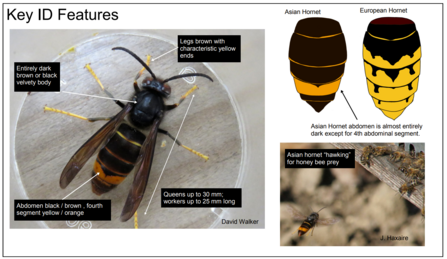The Asian hornet (Vespa velutina) is believed to have been introduced to Southern France in pottery derived from China in 2004. Since then, it has colonised France rapidly, spreading into Portugal, Spain, Belgium and Italy.
Why are Asian hornets a risk?
Asian hornets are opportunistic predators that feed on a variety of insects, including honeybees and other pollinators. They have been known to decimate honeybee colonies by preying on worker bees, which can have a significant impact on local ecosystems and agricultural pollination. Whilst they are more of a threat to honeybees, they do also predate on solitary bees and other invertebrates and it’s unknown at this time what affect they could have on our already dwindling insect populations.
The presence of Asian hornets can also have economic consequences. They can cause damage to beehives, leading to reduced honey production and the loss of valuable honeybee colonies. Additionally, the cost of controlling and managing Asian hornet populations can be a burden on beekeepers and agricultural industries. The estimated yearly costs for eradication would be €11.9M for France, €9.0M for Italy and €8.6M for the United Kingdom.
Efforts are made to monitor and control Asian hornet populations in the UK to mitigate their impact on both native wildlife and human activities. Early detection and reporting of Asian hornet sightings are important for effective management and control measures. Asian hornets and their painful stings only pose a risk to people who may be allergic to their venom.
Asian hornet nests
Asian hornets usually build their nests suspended in trees or in open large spaces. They build their nests, much like the European hornet, with regurgitated woody material which is why it looks like paper mâché. The nest is usually around half a meter long and egg shaped with entrances built all around the sides and bottom of the nest.
European hornets in comparison, usually build their nests in cavities and prefer their openings to be at the bottom of the nest.
The Asian hornet nest is estimated to release between 180-500 queens (compared to just one in a honeybee colony), which is exactly why they’re so hard to control.
